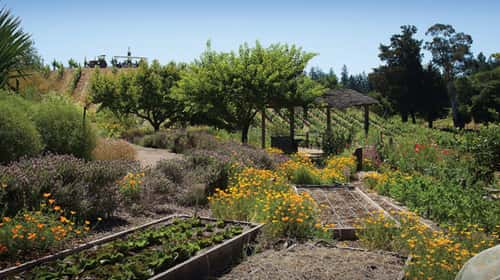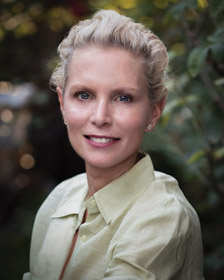
Seeking stronger relationships with the Earth and ways to express truly unique terroirs, winemakers and vineyard owners across Napa and Sonoma are embracing biodynamics —“organics on steroids”—in record numbers. In fact, Sonoma County has more than 20 certified Biodynamic farms and vineyards—more than any other county in the United States, according to Elizabeth Candelario, managing director of Demeter USA. (Demeter USA holds the certification mark Biodynamic and is the domestic arm of Demeter International, the oldest ecological certification organization in the world.)
To meet Biodynamic certification, a farm must meet all the requirements of organic, according to Candelario. “The entire farm must be certified, 10 percent of the acreage must be managed in biodiversity, and solutions for fertility and pest and weed control must arise from the farm system instead of being imported from the outside,” she says. “These practices were first described by Austrian philosopher and scientist Rudolf Steiner, who is most noted as the founder of Waldorf education.”
History
Similar to organic farming, but incorporating more esoteric concepts drawn from the ideas of Steiner, biodynamic farming officially got its name in the 1920s, though it has been practiced all over the world for centuries. Steiner was responding to a group of farmers in central Europe who were impacted by industrialization, explains Candelario. “Seeds were not germinating, animals were not thriving, the farms were losing their vitality and the food wasn’t as good. Steiner told farmers that instead of treating their farms as factories, they should envision them as living organisms—self-contained and self-sustained,” she says. That group of farmers organized to found Demeter International, named for the Greek goddess of agriculture.
To conventional farmers, biodynamic practices seem offbeat and “out there.” Cattle horns are filled with manure, buried during specific lunar cycles and then allowed to decompose for set periods before they are harvested to be used as fertilizer. Herbs, minerals and manure are composted/fermented to create preparations—also called “teas” or “preps”—that are used on plants and in the soils. Special plantings form insectaries, welcoming “good insects” that eat the bad insects. And so on.
In his “Biodynamic Mantra,” Lou Preston, chief farmer and owner of Preston Farm & Winery in Dry Creek Valley, notes that many of the biodynamic practices followed today seem “bizarre” compared to conventional farming standards. “But if you look at it from a historical perspective, there’s nothing new,” he says. “Native peoples on this continent farmed naturally and sustainably, and farmed for their community. Our distant ancestors claimed and awareness of universal energies that they channeled into their crops by the observance of rhythms and cycles, plus the application of minute amounts of animal, vegetable and mineral preparations to their soils, compost heaps and living plants.”
Sonoma County pioneer
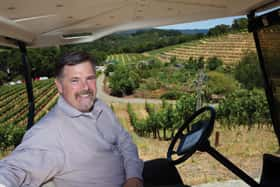 The first Sonoma County winery to be Demeter certified Biodynamic was Benziger Family Winery in Glen Ellen. Founder Mike Benziger, one of the pioneers of the wine industry’s biodynamic movement, got on board the biodynamic train in 1995. In 2000, Benziger was certified by Demeter and, in 2001, produced its first certified biodynamic wine – Tribute.
The first Sonoma County winery to be Demeter certified Biodynamic was Benziger Family Winery in Glen Ellen. Founder Mike Benziger, one of the pioneers of the wine industry’s biodynamic movement, got on board the biodynamic train in 1995. In 2000, Benziger was certified by Demeter and, in 2001, produced its first certified biodynamic wine – Tribute.
Going biodynamic was Mike’s idea, but according to his brother, Chris, vice president of trade relations, the entire family is totally dedicated to biodynamics.
“In some ways, the Benzigers are like the United States. There are red Benzigers and blue Benzigers, but we came together on this. We didn’t want to live on land we had poisoned,” he explains.
The road to biodynamic farming began by accident. “We basically screwed up, by following the norms of the time,” Benziger says. “When we first moved here in the ’80s, we sprayed and sprayed [chemicals] and pretty much nuked the vineyards. I remember walking through the vines and seeing less activity. The soil was rock hard, we had erosion problems and the grapes didn’t have much flavor. We realized we were wounding the soil and it wasn’t healing. Mike was fascinated with biodynamics; he had visited vineyards in Europe that were farming that way.”
The Benzigers turned to the late Alan York, a preeminent biodynamic consultant and a “guru of green,” whose fingerprints are on many of the nation’s top biodynamic vineyards. Alan helped us implement biodynamic farming practices, says Benziger.
“He loved our place – he called it a little island nestled against Sonoma Mountain,” Benziger remembers. Under York’s guidance, Benziger “went cold turkey, building insectaries and habitat highways. We did everything to attract natural predators for the insects we were trying to kill. We built birdhouses and owl boxes. The owls would eat the gophers and moles. We established a closed system. We still don’t throw anything away. We compost it. We have cows for manure and sheep that eat the grasses and till the land with their cloven hoofs and leave manure out the back end.”
The idea, Benziger says, is to make man part of the process. “You can’t make farming decisions in a boardroom miles away. You must be in the vineyards and have a connection to the land. We grew up on the ranch – both our family and our workers. We know every nook and cranny—where it’s wet and we need to open the vine’s canopy to protect from mildew, or where we need to grow leaves to protect the grapes from the sun. I’ve always said the best impression a winemaker can leave on his wines is his footprints in the vineyards.”
Sinskey’s Daydream
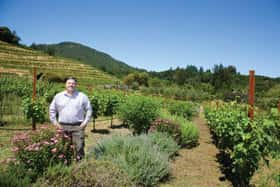 While Benziger Family Winery was making history in Sonoma County, Robert Sinskey Vineyards, located on the Silverado Trail near Yountville in the Napa Valley, was quietly adopting biodynamic practices as early as 1991, according to Rob Sinskey, son of the winery’s founder.
While Benziger Family Winery was making history in Sonoma County, Robert Sinskey Vineyards, located on the Silverado Trail near Yountville in the Napa Valley, was quietly adopting biodynamic practices as early as 1991, according to Rob Sinskey, son of the winery’s founder.
Like the Benziger operation, the initial Sinskey vineyards were in poor shape when Rob joined the team in the mid ’80s after a brief career in advertising in New York City and Los Angeles.
“My father planted the original vineyard and thought science could conquer all ills and out-compete nature,” says Sinskey, whose business card title reads “Daydream believer.” (If you can dream it, he says, you can make it happen.) “When I took over the operation with Jeff Virnig (winemaker) there was little soil percolation. When rainy spells hit, they took the topsoil. The soil wasn’t easily turned and there was very little microbial activity —no earthworms!”
Sinskey also looked at the way his neighbors were farming with chemicals, some even spraying vineyards with crop dusters.
“You had all these homes dotting this bucolic landscape. I didn’t think it was such a good [practice] to use potentially toxic chemicals so close to the homes. And it also didn’t make sense to be using toxics on something that was supposed to be a luxury product,” Sinskey explains.
Sinskey and Virnig concluded they should farm organically, but they needed a methodology to make better wine organically. Realizing that a lot of their favorite European wine producers were employing biodynamic principles, they hopped on a plane, went to France and learned all about it.
“A lot of people think biodynamics is voodoo,” says Sinskey. “Even Steiner thought he would be ostracized for promoting it.”
Sinskey started out with horns and manure, which he made into a tea and applied to one vineyard block that had phylloxera (aphids that live on and eat the roots of grapevines).
“We really had nothing to lose,” Sinskey says. “It was supposed to be a dead vineyard within three years. Instead, we began to see dramatic improvements in the health of the vines and the quality of the wines. But it took us about 10 years to get a handle on it, and start talking publicly about our practices.”
Sinskey relied on two consultants in the early years—York and “Amigo Bob” Cantisano, an organic farming advisor and founder of the annual Ecological Farming Conference, held each January at Asilomar in Pacific Grove.
“Back then, we had few role models, so we reached out to Amigo Bob and Alan York, the Crazy Cajun, who helped us cut through all the bull[crap]. York always said, ‘Don’t get caught up in the voodoo doo doo.’ They taught us how to be methodical and get it done,” Sinskey says.
At first, Sinskey’s father, who died two years ago, thought he and Virnig were “nuts.” “My father always gave me enough rope to hang myself, but so far I haven’t done it,” Sinskey says. “Once he saw the vineyard thrive and the quality of the wines improve, he began to understand that if you use the same toolbox as everyone else, the wine will taste the same. By working with nature rather than trying to conquer nature, you end up with wines that taste unique with a sense of place,” Sinskey says.
Today, Sinskey employs biodynamic practices in the 186 acres planted to vines in five vineyards he owns in Carneros (four in Napa and one in Sonoma), and one vineyard behind the winery in the Stags Leap District. His “dirt farmer and sheep wrangler” is Vineyard Manager Debby Zygielbaum, who spends most of her time enriching and managing the soil. And while he farms biodynamically, Sinskey is no longer certified by Demeter, and therefore doesn’t use the trademark.
Topolos Connection
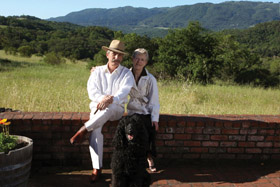 Like Sinskey, Robert Rex, winemaker and proprietor of Deerfield Ranch Winery in the Sonoma Valley is certified organic, but uses biodynamic farming practices. His mentor was Mike Topolos, who reached out to Rex, asking him to purchase grapes from Sonoma County’s oldest Merlot vineyard, which he then owned in Forestville (now Russian River Vineyards).
Like Sinskey, Robert Rex, winemaker and proprietor of Deerfield Ranch Winery in the Sonoma Valley is certified organic, but uses biodynamic farming practices. His mentor was Mike Topolos, who reached out to Rex, asking him to purchase grapes from Sonoma County’s oldest Merlot vineyard, which he then owned in Forestville (now Russian River Vineyards).
Rex went over to look at the vineyard and said he wasn’t interested in the grapes because the vineyard was in such bad shape. Topolos told him he was going to start farming biodynamically, and Rex would see a big difference.
A chemist, Rex initially linked biodynamics with the Farmer’s Almanac and a belief system “that’s not so scientific.” But he watched Topolos.
“That vineyard was overrun with Bermuda grass, which is almost impossible to eradicate. He got rid of it by burning it and spreading the ashes on the living Bermuda grass and within two years, all the Bermuda grass was gone. He planted trees along the highway that bordered the vineyard to soak up carbon monoxide from cars driving by and the vines close to the highway got healthier. I started making Merlot from the vineyard. Every year the vines got happier and the wine got better. I began to believe in biodynamics.”
According to Rex, there’s a difference between farming organically and farming biodynamically. “Organic farming is about what you don’t do, and biodynamics is proactive. With biodynamics, you repair the damage that farming does to the land. It’s a method of farming that restores and improves the environment. You localize your ecosystem, so you don’t bring in anything from the outside.”
At Deerfield Ranch, vine rows are planted in a curve to “keep energy inside,” Rex says. The vineyard is anchored with large boulders and Rex buries cattle horns filled with manure only on the vernal equinoxes. “I don’t dance around the maypole naked or sacrifice virgins, but it might be a good idea,” he laughs.
He works with the stages of the moon and seasons in all processes. He prunes the vines and harvests when the moon is active. In the cellar, he racks and bottles wine when the moon is quiet.
“Wine is a living thing affected by everything around it, including gravity and ions. I’ve noticed that Pinot Noir tastes more alive in the spring than the fall, no matter how old it is. Cab
(Cabernet Sauvignon) tastes better in the fall, when it is more settled,” Rex observes.
Rex is particularly sensitive to the forces of nature because his property – in the middle of Kenwood – is next to a valuable habitat: wetlands connected to a forest.
“There is a lot of wildlife,” he says.
Rex mostly grows Syrah, which benefits from the surrounding wetlands. “The vines are never without water,” he says. “We add biodynamic food and with the way we manage it (the vineyard), the wine reflects a very different profile—less earthy and better flavors. We wouldn’t get the same [result] with conventional farming.”
Stewards of the land
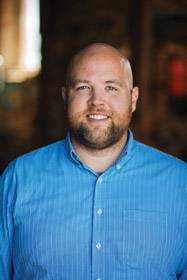 Ehlers Estate is another example of biodynamic farming, though it, too, is not officially certified by Demeter.
Ehlers Estate is another example of biodynamic farming, though it, too, is not officially certified by Demeter.
Ehlers Estate has been around since 1886 and has an interesting and very international history – founded by Germans and owned at various times by people of Italian, French, Hungarian and English heritage. In 2001, it was purchased by Jean and Sylviane Leducq, now deceased, who left it to the Leducq Foundation, which funds global cardiovascular research.
The winery began using biodynamic practices about 12 years ago, and the fact that it embraced organic and biodynamic methods was one of the main reasons Ehlers Estate was able to recruit its winemaker, Kevin Morrissey.
According to Kevin Jobe, tasting room manager, the Ehlers Estate mantra is: Stewards of the land first, vineyard second. “That comes from the winemaker, Kevin Morrisey,” says Jobe. “It’s the ego of the property. His mindset is that the tools coming from the vineyard make him who he is and that’s not taking anything away from the artistry of his craft. It’s simple. You give him lesser fruit, the wines will not be the same. Morrissy has made phenomenal wines all over, but working with this fruit [takes it] to a new level.
When Ehlers Estate replanted its vineyards some 17 years ago, special care was taken with the grounds. Weeds are burned out in the parking lot, but pulled by hand or shovel in the vineyards. Napa Valley grass-fed cattle manure goes into horns that naturally fall off, says Jobe, and the horns are buried for six months, then brewed as a “tea” that is sprayed on the vines as fertilizer during the night. “When we come into work 12 hours later, you would swear we are in full bloom,” says Jobe. “The vines drink it up.”
Ehlers Estate employs 24 people, 10 of them are vineyard managers/workers who work year-round and know the secrets of every vine. This hands-on approach is the key to Ehlers Estate wines. “We have our minds and our hearts in the dirt,” Jobe says. “And that’s the best thing we can do because it’s all about our future, too. We’re not milking the land dry for all we can.”
Farm first
When Lou Preston purchased the first parcel of his Dry Creek Valley farm in 1972, he thought his job was to plant it all in grapes. So, he did. His annual wine production hovered around 25,000 cases, but one year he had so much fruit, he produced 30,000 cases of wine. “We were bulging at the seams and using all the grapes,” he remembers. He made the decision to downsize. Today it’s called Preston Farm & Winery – and the emphasis is on the farm, first.
“Half of the property is dedicated to vineyards and wine,” Preston says. “The rest is for row crops and pasture for sheep. This is now a breeding farm and we sell lamb. We have laying hens, so we sell eggs.”
Several years ago, Preston – on a whim – planted heirloom apple trees. The man with a green thumb was then faced with an overabundant supply of apples, so he now makes natural cider.
Preston first began farming organically just before 2000, when he downsized. “We started rethinking our relationship with the land – what could we do that would be more interesting, more healthy. But we weren’t sure how to do it,” Preston explains. Enter Amigo Bob!
“The first thing Amigo Bob said is we have to buy as much compost as possible,” remembers Preston. “I kinda gulped because we used compost in a small garden out back of the house, but the thought of using it on 125 acres was a bit overwhelming – and expensive – but we did it. And he was right. The health of the land just blossomed the next spring. The other thing Amigo Bob did was introduce Preston to the community of people who farm organically – from farmers to ecologists to educators to activists.
As a natural progression, Preston began to pursue biodynamic farming principles. In the fall of 2015, Preston Farm & Winery became Demeter certified Biodynamic.
“I take great pleasure in the observance of the personality of our farm, the special qualities of the soil and the healthful foods that we raise here,” Preston states. “I can’t always explain why it works, but I know it does because I can see it and taste it. In wine parlance, it’s our ‘terroir’ – distinguished, special and unique.”
The forefront of change
For its part, Demeter USA sees Biodynamic agriculture and food production as a nascent but emerging trend. Last year the growth of biodynamically farmed acreage in the U.S. increased by about 18 percent, according to Candelario. And the natural food industry “is really starting to take notice,” Candelario says.
But it’s the wine industry that has taken the biggest leap.
“History will show one of the gifts of the wine industry to the entire American marketplace will have been the introduction of Biodynamic agriculture,” Candelario says.
And that puts the North Bay on the forefront of change.


